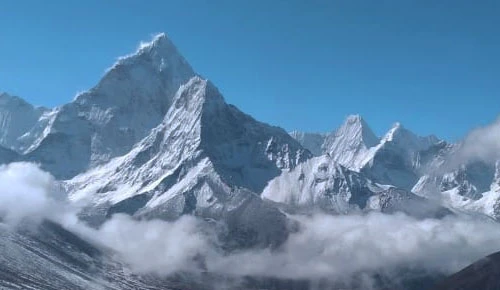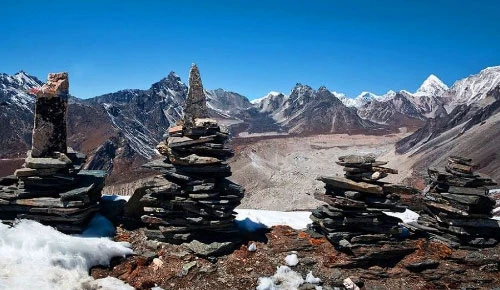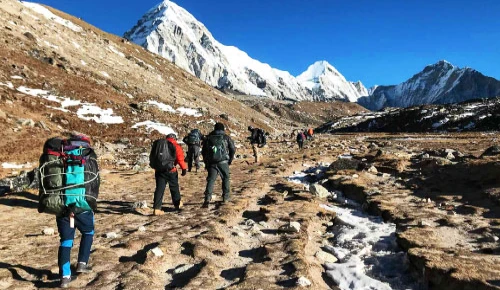Tips for Trekking to Everest Base Camp
Trekking to Everest base camp is one of the most demanding trekking routes in the world. It offers the chance to see Mount Everest from very close by hiking till its base camp.
It offers the best views of mountain ranges like Mount Everest, Lothse, Nuptse, Mount Makalu, and Gaurisankar. The alpine valley and forests, Gokyo Valley along with its lakes (Gokyo Lakes), and Himalayan Glacier of the Khumbu region are also the major highlights of this place. Mount Everest is located in Nepal at an altitude of 8,848.86 m (29,029 ft.) above sea level. It is known as Sagarmatha in the Nepalese language and Chomolungma in the Tibetan language. It provides the encounter to the path followed by the legends Sir Edmund Hillary and Tenzin Norgay Sherpa to summit Mount Everest.
If you are planning to trek to Base Camp, here is a list of 20 important Everest base camp trek tips to help you prepare:
Table of Contents
Everest Trekking Tips
Have you ever dreamed to reach the surrounding of the highest peak of the world? Are you thinking of going to the base camp trek of Everest to experience the snowy landscape of the Himalayan country, Nepal? If yes, here are some tips and terms that might be fully supportive of you to make your journey effective and the most memorable of your entire life.
1. Bring Cash (Nepalese rupees)
There are no ATMs in Lukla and the places above which we follow in the trial. So you need to take cash from Kathmandu. The exchange rates are also high in Lukla and above, so if you have dollars and other international currencies, it’s better to have them exchanged in Kathmandu. To have a pleasing trial, you are recommended to have money worth about $250.
2. Bring your Own Food Items (tea, chocolates, light snacks)
This is the most important tip for this trial. The walking time can go up and down, and there may not be hotels and tea houses for having food wherever you want. So, you must carry light snacks and dried fruits (like cashew, peanut, walnut, apricots, etc.), energy drinks, tuna fish, and many more. These will boost your energy and stamina to go further in the trek.
3. Have Your Gear
Some of the most important gears needed are trekking poles, hats, socks, down jackets, gloves, sleeping bags, etc. You can bring all these from your own country but that will make your luggage heavier throughout your journey through your country. So, to avoid that you can buy all these in Kathmandu. There are many outfitters and authentic stores that provide all these good-quality gear at cheap and negotiable prices.
4. Bring Water Bottles, Purifiers, and Purification Tablets
It is not possible to carry jars of water during your trip. Alternatively, you can carry water bottles so that you can pour them with water wherever you find them. All water may not be suitable for drinking. There you can use purifiers and purification tablets which will make the water suitable for drinking.
5. Pack Tang (drink) and Other Water Sweeteners
Dehydration is the major problem that occurs during the trek for hours and many people may feel normal water boring. You can add tang and other sweeteners to keep your body hydrated at higher altitudes. It can be more enjoyable than normal water too.
6. Get Your Trekking Map and Guidebooks
It is most to have with every individual to take reference about routes, altitude symptoms, and illness regularly. It will also help you make your expectation during the trek.
7. Take Proper Sanitizers and Hand-wipes
Taking showers and bathing properly at an altitude of 10oC is not that captivating. Of course, you will also not prefer that. But we also can’t deny the fact that we all smell after some time of bathing. For this, proper sanitizers and hand wipes will play a vital role to keep us healthy. Gold bond powders and sprays are mostly recommended items that will help you prevent itching and rashes.
8. Don’t Eat Meat After Namche Bazaar
Sherpas do not cut off animals at that altitude, so they carry it for days from lower altitudes or Kathmandu. There is no guarantee of it being fresh. Meat also takes lots of time to digest. So, it is highly recommended not to take in meat after Namche Bazaar.
9. Keep Batteries With You as Close as Possible
The cold drains the battery faster and it is very expensive to charge batteries there. It takes about $5 per hour to charge it. You can extend their life keeping them as warm as possible.
- Near Namche Bazaar: NRP 150 to 200 per hour
- Near base camp: NRP 300 per hour
10. Best Views are in the Morning
Early in the morning, the clouds roll speedily which offers the best panoramic view over the surroundings and some points of Mount Everest as well. You can take photos and videos as much as you can to make long-lasting memories.
11. Don’t Get Afraid of Suspension Bridges
It is one of the weirdest but most important tips for this trek. The suspension bridges are safe and are in good condition but some people may freak out while crossing them as it is long and swinging. You can catch the edges or the hands of partners if you have fear of crossing it.
12. Have Food in Jorsale Before Namche Bazaar
After crossing the suspension bridge, you will stop at Jorsale for having food. The trek from here leads upward to Namche Bazaar which is steep 2 hours of climb. You can have food and water, and fill water in bottles as t is the final place for having food before Namche Bazaar.
13. Shopping in Namche Bazaar
The Sherpa stores in Namche Bazaar provide various national appealing stuff that you can find nowhere. You can buy some of those in Namche Bazaar as per your budget while returning home. It can be the best emblem from Nepal for you to take to your country. You can also buy the stuff that you may have forgotten to buy earlier.
14. Have a Good First Aid Kit
At the high altitude of the Everest region, you can strike from the diseases like altitude sickness, vertigo, and many more. So, you should take proper medicines, bandages, and tablets so that you could take them at the time of need. Also, make sure that you have proper decongestants, Diamox, sinuses, and nose lubricants as well.
15. Bring Extra Pairs of Sunglasses
At the high altitude, it is possible that you suffer from altitude blindness and to prevent it you can carry extra pairs of sunglasses. It will also prevent you from sharp rays coming from sunlight, which will aid you in climbing smoothly.
16. Backpack Well
It is very essential to carry the stuff needed for trekking for oneself. To know the details about backpacking and necessary stuff, you can check in to the Travel resource section of our site or simply click on the link Backpacking Checklist.
17. Respect Local Culture
You will encounter the prayer flags, rocks, and walls during the trial. Local people respect and worship those assets which are the important custom for them. You should also try to follow or simply respect their customs. There are also some photography-restricted areas (like the interior of monasteries) so you should ask before engaging in any kind of such activities. If you are willing to take photographs of a person or monasteries, you should simply take their permission.
18. Braid Your Hair
Keeping long hair might be unsupportive during the trial. It becomes dirty earlier and there is not much chance of getting a shower, which will lead you to encounter bugs, rashes, and allergies. You are recommended to have your hair cut shorter. It can also come in front while ascending and descending which will, of course, disturb you.
19. Hire Porters and Guides in Kathmandu or Lukla After Your Arrival
You are recommended to hire guides from Nepal rather than from your own country. If you book from your native country, there are chances of being corrupted and a large amount of money will go into the native porters’ pocket. So, you can hire porters and guides from Nepal (you can hire from both Kathmandu and Lukla) who will be provided to you at a very cheap and negotiable price.
20. Keep Books
Everest Base Camp itself is an interesting trek but sometimes you may feel tired and bored. In those times you can read novels, magazines, and journals, as well if you are not supposed to roam here and there. You can save your energy lying down in bed and reading books, so bring the good ones. It will also make your mind focused and relaxed. It is better than moving randomly with no purpose.







